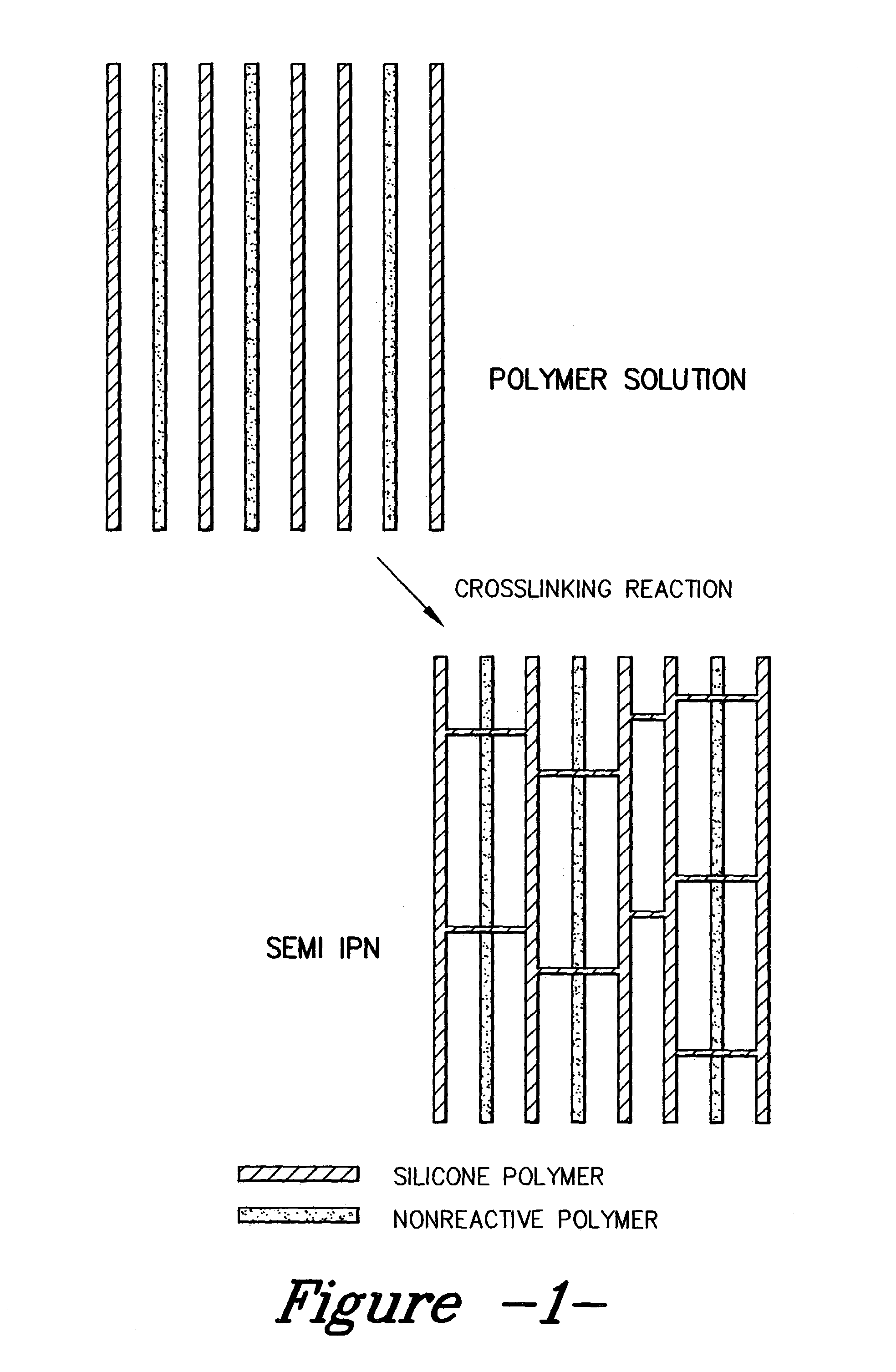Polymer coating blends
a technology of silicone polymer and blend, which is applied in the field of adhesive coatings, can solve the problems of high cost, high cost of silicone compound, and high cost, and achieve the effect of improving properties, enhancing the ability to form effective ipns, and enhancing the ability to impart particular properties to silicon
- Summary
- Abstract
- Description
- Claims
- Application Information
AI Technical Summary
Benefits of technology
Problems solved by technology
Method used
Image
Examples
example 1
[0034]Fifteen parts of VAMAC® DP (an ethylene methyl acrylate copolymer from DuPont Polymers; δ=18 MPa1 / 2 (calc)) was dissolved in toluene to make a 25 percent solution. This material was then added to 85 parts of a two-part silicone polymer, Shin-Etsu Chemical Co., Ltd., KE-2001-50 A / B, with 1.0 phr of γ-isocyanatopropyl-trimethoxysilane (available from Shin-Etsu Chemical Co. Ltd.; under the tradename KBE9007) and the resulting mixture was diluted to 50 percent solids with toluene.
[0035]Comparatively, the two-part silicone polymer of EXAMPLE 1, above, was utilized without the added ethylene-methyl acrylate copolymer. These materials were then individually coated onto separate 420 denier, nylon 6,6 Jacquard woven one-piece airbag cushions of dimensions 800×250 mm, using a knife coater, dried for two minutes at 150° C., and cured for seven minutes at 170° C. The dry coating weight was 2 ounces per square yard. The characteristic leak-down time from an internal inflation pressure of 2...
example 2
[0036]A twenty-five percent solution of fifteen parts of LEVAMELT® 500 (ethylene vinyl acetate copolymer from Bayer Corporation; δ=18 MPa1 / 2 (calc)) in toluene was substituted for the twenty-five percent solution of VAMAC® in the formula described in EXAMPLE 1. This material was coated onto the same airbag fabric and processed and tested in the same manner. The results follow:
[0037]
Time for internal pressureTime for internal pressureto fall from 20 to 10 psito fall from 20 to 10 psi(seconds) for 100%(seconds) for IPNExampleSilicone Polymer(silicone + second polymer)15292560
[0038]To assure that the results noted above were due to the effect of the IPN and were not restricted to the silicone polymer studied, the process was repeated with another silicone polymer.
example 3
[0039]The process described in EXAMPLE 1, was repeated, substituting a two part silicone polymer, RHODORSIL® LSR60HS (produced by Rhodia Silicones) in equal weights for the Shin-Etsu product. Because the Rhodia product is intended to be used as delivered, no γ-isocyanatopropyltrimethoxysilane was added. The material was diluted, coated and the results measured as in EXAMPLE 1. Comparison was made to a coating derived solely from the Rhodia product. The results follow:
[0040]
Time for internal pressureto fall from 20 to 10 psiTime for internal pressure(seconds) for 100%to fall from 20 to 10 psiExampleSilicone Polymer(seconds) for IPN31781
[0041]It is well known and well understood within the airbag art, particularly concerning side curtain (low permeability) airbag cushions, that retention of inflation gas for long periods of time is of utmost importance during a collision. Side curtain airbags are designed to inflate as quickly as driver- and passenger-side bags, but they must deflate ...
PUM
| Property | Measurement | Unit |
|---|---|---|
| linear density | aaaaa | aaaaa |
| pressure | aaaaa | aaaaa |
| pressure | aaaaa | aaaaa |
Abstract
Description
Claims
Application Information
 Login to View More
Login to View More - R&D
- Intellectual Property
- Life Sciences
- Materials
- Tech Scout
- Unparalleled Data Quality
- Higher Quality Content
- 60% Fewer Hallucinations
Browse by: Latest US Patents, China's latest patents, Technical Efficacy Thesaurus, Application Domain, Technology Topic, Popular Technical Reports.
© 2025 PatSnap. All rights reserved.Legal|Privacy policy|Modern Slavery Act Transparency Statement|Sitemap|About US| Contact US: help@patsnap.com

